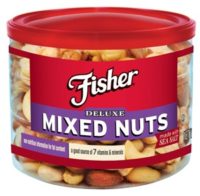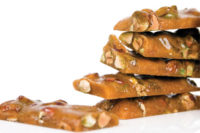Candy consumers and suppliers alike seem to be going nuts these days.
As nutrition bars become more poplular, so does the demand for nut-based products. And, the ways to include nuts in confections are constantly evolving, as demand continues to increase.
For example, Hampton-Farms-Jimbo’s Jumbos has noticed a rise in nut consumption, specifically peanuts, and attributes it to the increased consumption of energy and nutrition bars.
Peanut butter is being used nationwide to achieve a “tasty breakfast bar, energy bar or delicious snack,” says Mike Partin, the company’s regional sales manager.
“Peanuts are nutritious and are available at a great value for the confectionery industry,” Partin continues. “They are heart healthy; reduce the risk of diabetes and help in weight control, when eaten in moderation.”
Hazelnut Growers of Oregon also has seen a steady growth of about 20 percent year over year to confectionery companies, supplying the industry with value-added hazelnuts diced, roasted, paste and butter as well as almond butter.
Currently, the Cornelius, Ore.-based, harvester is working with Oregon State University’s food R&D class to develop new butter and paste products in hopes of bringing a chocolate hazelnut base to the market by next year, says Lucas Schmidt, industrial sales manager at HGO/Westnut.
“Consumers are very well informed these days and they view confectionery products containing nuts as a healthy way to indulge their sweet tooth,” says Schmidt. “For instance, a dark chocolate bar with roasted hazelnuts isn’t just a high-end candy bar anymore — it’s seen as a super food energy bar.”
Chocolate and nuts seem to go together like peanut butter and jelly. And one of chocolate’s most popular inclusions is almonds.
”The confectionery industry is where the versatility of almonds is really able to stand out,” says Bill Morecraft, general manager of Blue Diamond Almonds Global Ingredients Division.
He notes whole almonds tend to be used in either enrobed chocolate, chocolate bars or in a panned types of candy products, such as an almond with a flavored, hard candy coating or sugar coating. Sliced and diced almonds, he says, would typically be found in bars or enrobed products and almond paste or almond butter can be used as a base for a filling or as a stand-alone filling for chocolates.
“Almonds fit very nicely into today’s trends in confectionery,” Morecraft continues. “Research indicates that consumers want to be able to ‘justify’ a chocolate indulgence. Almonds can add texture, ‘crunch’ and enhance nutrition when used as an ingredient in chocolates.”
Almonds enhance a product’s value, premium position and nutrition, he continues. With an increase in snacking, Morecraft notes chocolate manufacturers have to offer products that meet the consumers’ desire for indulgence while fulfilling that need for a healthier snack.
And, bold flavors are in, says Morecraft — from wasabi and Thai chili to smoked and bacon.
“When bold flavors are combined with chocolate, they provide an unexpected treat when consumers do decide to indulge,” he says. “Sweet flavors with chocolate also make for a nice pairing. It’s all about finding the right combination.”
He says Blue Diamond continues to work on flavored almonds.
“Whether the almonds are whole, sliced or diced, almonds can carry a product’s flavor profile when used as a primary ingredient.… The versatility of almonds comes through because of the breadth of flavor possibilities available for almonds.”
“Sweet and salty combinations are gaining traction and we see growth in nut butter and nut butter-containing products,” he continues. “Generally speaking, we see more companies are favoring domestic nut products over imported products and looking to work with companies that have a high-level QA program in place.”
Food safety critical
Blue Diamond recently opened its newest almond processing plant in Turlock, Calif.
The facility was built with the most stringent processes available for food safety with controlled atmospheric conditions to filter airflow and temperature, Morecraft says.
“With strict, controlled access to the production area, the ‘clean-room’ technology is the best step to optimize a food-safe environment,” he says.
It all begins in the field where the product is sorted, he continues. ”As the almonds migrate from the hulling/shelling process to the first delivery at the brown almond processing center, steps are taken to further identify and separate any foreign materials. As the nuts are further processed they go through some of the most state-of-the-art electronic sorting processes to remove any remaining foreign material. In the end, Blue Diamond’s standards for foreign material are known to be the most stringent in the industry.”
“Regardless of food product, food safety is always paramount, which is why so many confectioners who work with nut products look to partner with a manufacturer they can trust,” adds Schmidt. “We undergo over a dozen audits each year to ensure our QA programs are up to industry standards and that our COA sampling and testing programs are being strictly adhered to.”
At Hazelnut Growers of Oregon, Schmidt says there are several areas in the plant dedicated to the removal of foreign material, such as sticks, shells, and other debris.
“We use air lags, shakers, laser sorters, metal detectors and hand sorting to remove foreign material. We constantly monitor the foreign material as it’s removed.”
And, every lot the company produces undergoes micro and chemical tests to ensure all the nuts and nut products are within specification. “Until we have lab results back showing the product is within our spec, we do not ship,” Schmidt says.
Meanwhile, Hampton Farms-Jimbo’s Jumbos also uses the most advanced sorting equipment available in the industry to ensure foreign matter doesn’t get shipped with the product.
“Optical sorting equipment is a must as well as gravity separators, air separators, metal detection and manual sorting,” says Partin.
Yet, the biggest health concern, according to Partin, is with peanut allergies. He notes The Peanut Institute is working toward a cure though.
At the end of the day, it seems to be a search for healthier confections and snacks that’s driving the increased use of nuts. And as long that trend continues, candy companies will continue to go nuts for peanuts, hazelnuts, almonds and all the other nuts on the market.












